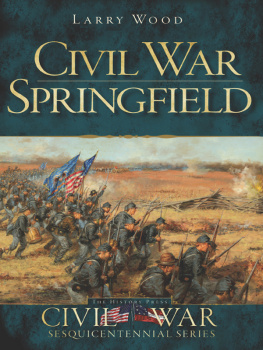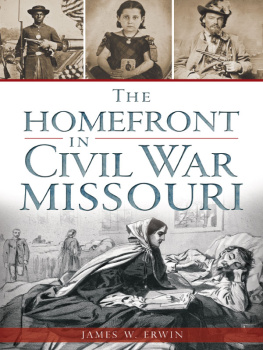
Published by The History Press
Charleston, SC 29403
www.historypress.net
Copyright 2014 by Larry Wood
All rights reserved
Cover image: Battle of the Hemp Bales, by Dale Gallon. www.gallon.com.
First published 2014
e-book edition 2014
ISBN 978.1.62585.070.6
Library of Congress Cataloging-in-Publication Data
Wood, Larry (Larry E.)
The Siege of Lexington, Missouri : the Battle of the Hemp Bales / Larry Wood.
pages cm
Includes bibliographical references and index.
print edition ISBN 978-1-62619-536-3
1. Lexington, Battle of, Lexington, Mo., 1861. I. Title.
E472.25.W66 2014
977.845303--dc23
2014011665
Notice: The information in this book is true and complete to the best of our knowledge. It is offered without guarantee on the part of the author or The History Press. The author and The History Press disclaim all liability in connection with the use of this book.
All rights reserved. No part of this book may be reproduced or transmitted in any form whatsoever without prior written permission from the publisher except in the case of brief quotations embodied in critical articles and reviews.
CONTENTS
ACKNOWLEDGEMENTS
I want to thank a number of people who contributed to making this book a reality, and Id like to start with fellow Civil War historian James McGhee because it was he who encouraged me to write the book in the first place. In addition, he supplied a list of suggested sources and even provided transcribed copies of some of those sources. Finally, he read a first draft of the manuscript and provided valuable comments.
I need to thank Janae Fuller, administrator of the Battle of Lexington State Historic Site, for her help and cooperation during my several visits and numerous phone calls to the site, and she also supplied several photos for the book. I also want to thank John Maki, groundskeeper at the state historic site, for showing me around Lexington and pointing out the various places of interest related to the battle. In addition, John answered a number of my questions, particularly those pertaining to the battleground, and he, too, provided several photos. John also served as an early reader of the manuscript.
As usual, much of my research for this project was done via interlibrary loan, and I want to thank the reference staff at the Joplin Public Library, especially Patty Crane and Jason Sullivan, for cheerfully filling my interlibrary loan requests.
I made several trips to the Hulston Library and Museum at the Wilsons Creek Battlefield National Park, and I need to thank librarian Jeff Patrick and museum technician Alan Chilton for helping me with my research during those trips. In addition, I want to express my appreciation to museum curator Deborah Wood for supplying numerous images for this book.
I also made a couple trips to the SpringfieldGreene County Library, and I want to thank local history librarians Patti Hobbs and Michael Price for their help during those visits.
During my visit to the Missouri Southern University Library, Penny Richeson of the audio-visual department and archivist Charles Nodler were very helpful.
Thanks to the staff at the State Historical Society of Missouri, especially to Laura Jolley for her help during my visit to the organizations research library in Columbia. Thanks also to Beth Lane and LeAnn Arndt of the societys Rolla branch for arranging for me to research some of the societys collections at the Missouri State University (MSU) Library in Springfield. Thanks, too, to Nathan Neuschwander and Sue Reichling for their help during my visit to the Music and Media Collections of the MSU Library.
Thanks also to Steve Mitchell and Robyn Burnett for their help during my visit to the Missouri State Archives in Jefferson City.
I want to thank Molly Kodner and Jaime Bourassa, associate archivists at the Missouri Historical Museum. Ms. Kodner responded to several research requests that I made via e-mail, and Ms. Bourassa supplied several photos from the museums collection.
Thanks to Doug Gifford for furnishing me a copy of the John Taylor narrative, of which I had been unaware until I read his Lexington Battlefield Guide.
Joe Maghe kindly provided me with photos of several pertinent items from his Civil War collection.
Thanks to my wife, Gigi, for serving as a proofreader of the manuscript, for her help preparing some of the illustrations, and for her continued support.
Lastly, I need to thank Adam Ferrell, editorial director of The History Press, and Jaime Muehl, editorial department manager of The History Press, for her excellent edit of the manuscript. The book is more polished because of her professional attention to detail.
Chapter 1
LEXINGTON
Early 1861
On the eve of the Civil War, Lexington, Missouri, was the fifth-largest town in the state with a population of over four thousand people, and it was the most important trading center on the Missouri River between St. Louis and Kansas City. Lexington was a commercial hub for the surrounding agricultural region, where wealthy, slaveholding planters reaped large profits from growing hemp, tobacco, and other products. Warehouses and factories lined the riverfront, and the town boasted three colleges, two newspapers, eight churches, and numerous thriving businesses.
However, the towns sense of prosperity and tranquility was interrupted, as it was in the rest of the nation, by rumblings of war in the early months of 1861. Susan Arnold McCausland, a twenty-one-year-old newlywed living in Lexington at the time, recalled years later, It was war time in the land, and Missouri was feeling the stir of the situation throughout all her bounds. In the little town of Lexington on the river there wasan eager impulse toward matters military, without however, any pronounced feeling of taking the side of either the North or South.
Susan McCauslands memory of the situation in Lexington reflected Missouris position of armed neutrality, which meant that it would support the Union as long as Federal troops stayed out of Missouri and did not try to coerce the seceding states. Outgoing governor Robert M. Stewart had advocated such a position in late 1860, and incoming governor Claiborne F. Jackson had embraced it, at least nominally, when he took office in early 1861. A small but vocal minority of the states citizens, concentrated in various rural areas, advocated immediate secession, and a similarly small but adamant group, led by a large German population in and around St. Louis, was made up of unconditional Unionists. However, the large majority of citizens were conditional Unionists who favored the position of armed neutrality, and a state convention called to consider the question of secession had voted overwhelmingly in March to stay in the Union, even though Missouri was a slaveholding state.

Claiborne F. Jackson, Missouris Confederate-allied governor. Claiborne Jackson, #11499, in the collection of Wilsons Creek National Battlefield. Courtesy of the National Park Service.
Describing the same disposition toward neutrality that Susan McCausland recalled, the author of the 1881 History of Lafayette County said that the first military company raised in Lexington during the early days of 1861 was composed of men of all shades of political opinion, the most of whom were of mature years. The county history said the first company was commanded by Captain John Tyler, who later entered the Union army, but Mrs. McCausland remembered that her father, Major E.G. Arnold, who was a graduate of the Virginia Military Institute, and Captain George Wilson, a West Point graduate and former officer in the U.S. Army, also led drills on the wide and beautiful campus of the old Masonic College. In any case, the companies formed during the early months of 1861 were intended merely for home protection and to enforce Missouris policy of armed neutrality. These half-play companies, as Susan McCausland called them, favored neither the North nor the South but instead sought merely to maintain peace and to protect Lafayette County citizens from invasion by any outside force.
Next page








